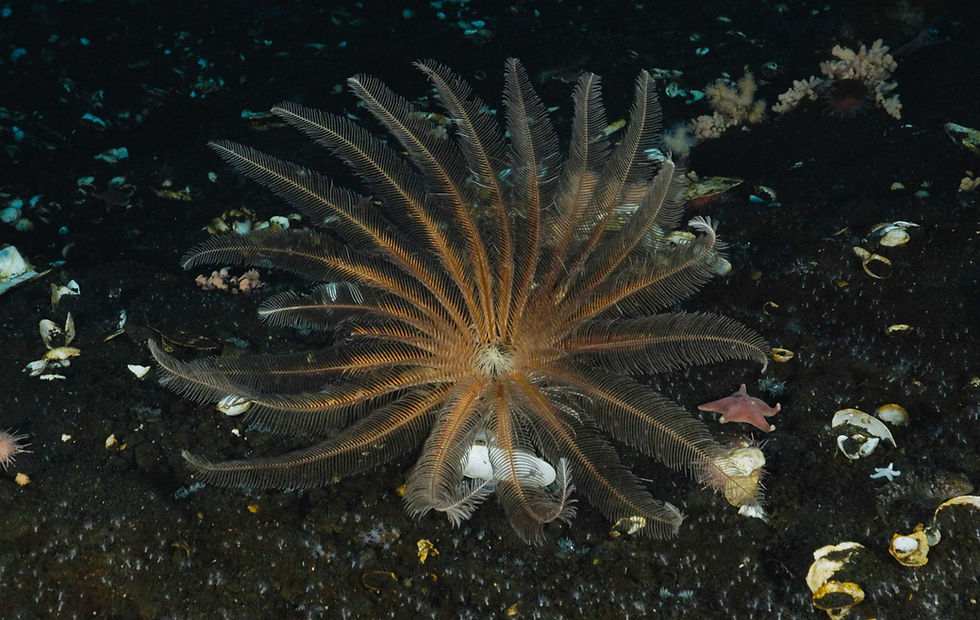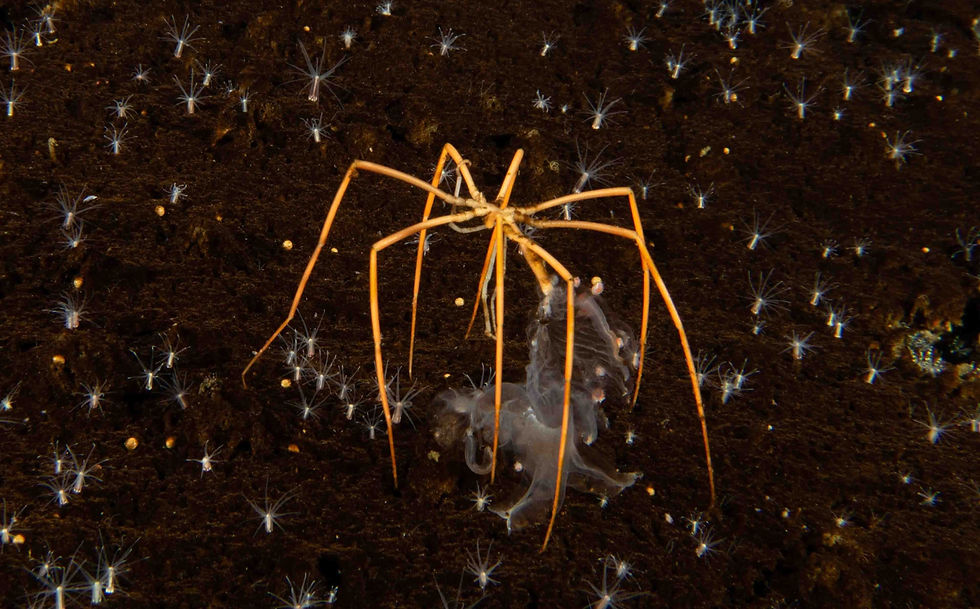Eerie Encounters
- Rowan McLachlan
- Sep 30, 2022
- 5 min read
Updated: Aug 20, 2023
A few days ago, I had an eerie encounter at the end of our dive. We were diving at the site known as Dayton’s Wall. Our dive plan was to descend under the ice hole to about 100 ft depth and gradually make our way up the slope towards the shore until we reached the anchor ice at about 15 ft depth, at which point we would do our 3 min safety stop before swimming back under the sea ice ceiling towards the ice hole.

Panorama of Dayton's Wall. Photo credit: Rowan McLachlan
One of the most amazing aspects of diving here in Antarctica is the underwater visibility. During the winter months, there is very little plankton in the water, and consequently, the water column is phenomenally crystal clear. Typical visibility range (the distance you can see underwater) between August and September in the McMurdo sound is 900 ft (~275 m) - for all the divers reading this right now – that is not a typo! From October onwards, the increased sunlight and solar radiation gives rise to an annual plankton bloom that eventually reduces the visibility substantially.

The banding patterns we see above us is caused by the thickness of the snow lying on top of the sea ice. Photo credit: Rowan McLachlan
This amazing underwater visibility means that objects underwater appear closer than they are – which is great for spotting wildlife, but less great for judging how far you are away from the escape hole - what you think is a quick 2 min swim home can turn out to be more like a 10 min swim!

This photo was taken at the Jetty site, but gives you an indication of how good the visibility is here. I am about 200 ft away from this slope when I took this photo!
So, there we were, about 15 mins into the dive, cruising around at about 60 ft depth. I look around at the rest of the team (just Andrew and Rob on this dive) and everyone is hovering about a foot above the seafloor taking close-up macro-photographs of some critter or other.

Photo of Andrew Thurber taking close-up macro photos of a sponge. Photo credit: Rowan McLachlan
I like dives like this as they are super chill and very Zen. The underwater camera that I had on this dive (Canon G7X) was currently configured for wide-angle landscape shots (not macro), so I was paying less attention to the plethora of small creatures on the seafloor, and instead taking in the entire scene: the continuous seafloor slope sprawling before us, the vast expanse of colorful ice above our heads, the deep blue open water to the rear. I was continually scanning in all directions in the hope of spotting a curious Weddell seal cruising by – they can appear from basically any direction: through a crack in the ice above us or from the dark abyss behind us.

This is a photo I took on a previous day diving at the Jetty. The Weddell seals are very curious, and often swim right up to us and sing their eerie songs. Photo credit: Rowan McLachlan
As I hovered weightlessly in the water taking in the landscape, I spotted a dark foreboding shape in the distance maybe 100 ft away. It was in the shallows at about 15 ft depth. At first, I thought it might be a pocket of air expelled by us on a previous dive, that was now trapped against the ceiling. However, the shape then began to expand…

Whatever this thing was, I could tell that it was big - like the size of me, big. Suddenly, the shape stopped growing, and instead started to contract.

The wispy shape reminded me of smoke – constantly changing shape, but never materializing into a single form. For those Harry Potter movie fans out there – if you have seen the movie “Fantastic Beasts and Where to Find Them”– this thing reminded me of the Obscurus:

When I thought this, I got a little scared. Was I really witnessing an alien shape-shifting life-form - or worse – was I hallucinating because I was narc’d? One of the risks SCUBA divers face when diving at depth is succumbing to nitrogen narcosis (a.k.a. “getting narc’d”) – a condition caused by breathing gas at high pressure which can cause an anesthetic effect that alters a diver’s consciousness.
At this point, I wanted confirmation that I wasn’t going crazy. I tried to get the other divers attention using my camera strobe, but everyone was very engrossed in their photo-taking. Alas, the only way to find out what this was, was to approach.
It wasn’t until I was about 30 ft away that I realized what I was seeing: a very, VERY large jellyfish! The diameter of the bell was easily a meter across. With a bell that large, I could only imagine how long its stinging tentacles were (jellyfish can often have tentacles that are tens of feet long). Hence, I was extra-cautious. Every kick I took closer, I was scanning the water column to make sure I wasn’t about to entangle myself in tentacles. One of the pros of ice diving is that 99% of your skin is covered and only your lips are exposed. Regardless, I didn’t really want to end up with a jellyfish sting on my face, nor have to untangle my suit from them later.
When I reached about 15 ft depth, I can see that the jellyfish had no long tentacles. It is possible that there were just retracted, but more likely it that they had been torn off by the ice. A big jellyfish like this is not normally found in the shallows so close to shore, and instead is commonly found out in the deep open water. Unfortunately for this one, it seems as though it had been carried inshore by a current and inadvertently become trapped under the ice.
After making this realization, I felt comfortable getting close to it. I took these photos about 2-3 ft away from the jellyfish. Photo credit for all photos below: Rowan McLachlan.
This species of jellyfish is known as Desmonema gaudichaudi.

Photo credit: Rowan McLachlan
It is found in Antarctic and subantarctic waters, Tierra del Fuego, Falkland Islands, Argentina, Kerguelen Island, Heard Island, southern Australia, and New Zealand. It can have anywhere between 10 to 60 thickened tentacles, and often has symbiotic fish living amongst its tentacles! They also carry a parasitic hitchhiker which munches on their gelatinous flesh: an amphipod crustacean called Hyperia macrocephala.

Source: https://www.sealifebase.ca/images/species/Hymac_u3.jpg
I was ecstatic at the end of this dive. What started out as a nerve-wracking curiosity ended with an amazing encounter with a phenomenally beautiful animal. This is why I love the ocean - it's filled with wonderful aliens!































Comments